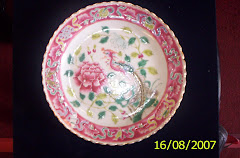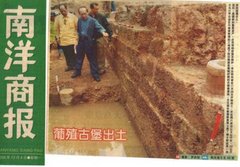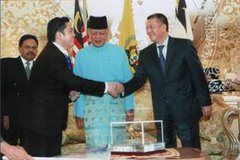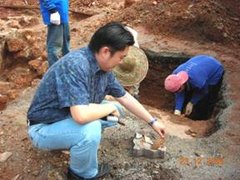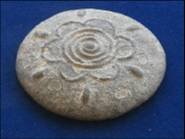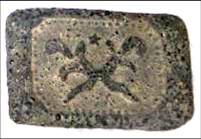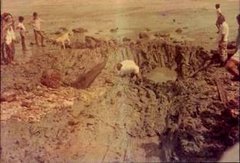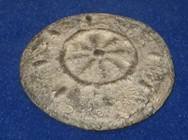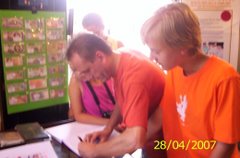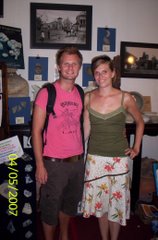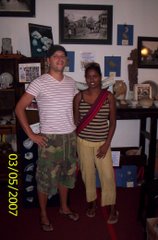
Thursday, May 17, 2007
Tuesday, May 8, 2007
MAM Disagreed With Joe & Other On Definition of “Magic Coins”
“…….The term “magic coins” used throughout this volume of Joe Cribb is an invented name for the objects being discussed only. Covarrubias used the term “magic coin” to describe the pieces he was told about (Cavarrubias 1937, p. 142) . Hobart also chose the word “magically” to convey her informant’s description of the power of the coins (Hobart 1987, p. 189). Rentes stated that the pieces he saw ‘never used in currency, but, purely for magical purposes’ (Rentes 1936, p. 302). He also used the Malay word ‘keramat’ to identify the magical power which the coin embodied . The equivalent word in Javanese is ‘ kasekten’ (meaning supernatural power) (Koentjaraningrat 1985, p. 412)…..”
Joe Cribb in his volume, page 82, “…….‘Magic Coins of Java, Bali and the Malay Peninsula” mentioned that : “….The use of coin-like charms in China was a very powerful custom which gave rise to the creation of a large and diverse range of designs, seeking many different benefits for their owners. The custom also spread to Japan, Korea and Vietnam, adding to the range of designs and functions. Examples invoking the forces of Confucianism, Daoism, Buddhism and Shintpism are documented (Hou 1975; Wang 1997, pp 150-5; Cribb 1986, pp 153 and 156; Cribb 1986 ; Thiery1987; Kugahara 1972)……”
Cribb must have confused over the real teaching of Buddhism and Taoism, also between the Confucianism and Buddhism, and between the Buddhism and China folk custom, folk lore. For instance, in the real Buddhism world and promoting, Buddhism never used such so-called coins-like as “Buddhism amulets “ as many described
This is a highly misleading statement made, which may cause a lot of misunderstanding of their so-called academic study of “magic coin” and “Flower Money” of China community were practicing, since early Han Dynasty, which North Song officially documented in “ “Chuan Zhi” by Hong-Jhun and Encyclopedia of Ancient Coinage” by Ting Fok-Poh.
MAM prefers this naming of ‘ magic coins’ for China coin-like be originally termed as “Flower Money” which can be categorized into 9 Category with 42 functional purposes, ( in Chinese, called : ) ,
from human being of their “Life, Ageing, Sick and Die” closely linked with their living environment, beings, planet, gods and devils, animal and lives on earth, underwater or space, its materials used consists of gold, silver, bronze, copper, lead & tin.
Here, MAM must clarified that Buddhism never in any form to encourage this kind of folk religious ceremony or for any personal ritual offering
In fact, what all read and were told are some form of Taoism religious function, and mostly are conducted for local folk customs. Hence, never have any of ‘Buddhism amulet” be created or issued by Buddhism temples or organizations or private communities.
s, as superstition is strictly prohibited from Buddhism.
MAM should advised those academic researchers and archaeologists of these magic coins that the word of “Buddhism amulets” (page 88, Cribb volume, refer to Thailand Tambiah case of age and authenticity of an amulet used in Thailand ) should not be used to describe these magic coins for charm or temple ritual offerings, as this is highly sensitive issues of describing these ‘magic coins ‘ especially of Chinese-style’ be confused with real teaching of Buddhism, as what Joe explained early!
Again, Joe Cribb related the “…Islamic magic coins from the Malay Peninsula (Series 17 & 18) (Page 88) were designed to meet the requirement of users…..in the Malay Peninsula such activities are identified as magical because the deities invoked are not part of Islam, the socially and officially recognized orthodox religion of the region. In some senses it is the popular or folk religion of the Malays – as distinct from orthodox Islam, but it involves Islamic beliefs while also carrying traces of the earlier religion of the local peoples, a mixture of Hinduism, Buddhism and local shamanic beliefs. These systems were reinforced by the immigration of Javanese during early nineteenth century…”
MAM would also like to see clarification from Joe Cribb that MAM never seen these so-called “Islamic magic coins from the Malay Peninsula” , as what Joe mentioned, also never be found any of this kind in Melaka discovery since 1969-2004.
We also doubted in some aspects of what Joe researched in the above paragraph, regarding the mentioned “Islamic magic coins of Malay Peninsula”. These “ Islamic magic coins” is definitely very much different from what MAM found in the areas of Melaka, especially those categories of Malacca Sultanate Period, we termed as “Islamic Money” and “Animal Money”, either in form of their designs, materials used.
Question now is: Can these officially issued, government-backed monetary of China Copper Cash Coins be classified and categorized as “Magic Coins” or “ as “Charm “ or “ Temple Offerings ” or “Ritual Ceremonial “ or personal “Amulets” just because they are used and found in many religious and ritual purposes recently or reported ?
This is the key question MAM would like to seek clarification and explanation from those always claimed & termed the “Melaka animal money” as “Magic Coins” or “For Charm or religious Offerings purposes ”?
Where are the archives or official documents did reported these animal money were found and used for ritual or religions purposes, or for personal charm and amulet?
When and where these animal money were discovered and proved to be used for these purposes? All parties claims need more comprehensive academic materials and solid archaeological data or environmental evidence to substantiate it.
Or, it is most appropriate and more professionally and ethically to categorize these currency used in any religious and ritual purposes, is due it Royal authority and Royal power endorsed by those Kings, Emperors or Sultans, Rajas, to exorcise their most feared gods and devils, as what China copper cash coins be used widely in Nusantara and Mainland China for Taoism religious functions and ritual purposes?
MAM also never come across any official documents or archive of Malaysia, or from London, or China regarding these “ animal money” has been used in any religious functions, communities ritual or celebration purposes. Here, MAM prefer to jointly conduct further study and comprehensive academic research and archaeological study for these controversial issues, with PERZIM and Muzium Negara or any other relevant interested parties, either from domestic or overseas, or jointly.
MAM has put up this Proposal officially to PERZIM of Malacca State Government, also to Muzium Negara of Federal level.
Datuk Chan Teck Chan, JP
President of MAM
Committee Member of ICOMON (Money & Banking), UNESCO, United Nations
Joe Cribb in his volume, page 82, “…….‘Magic Coins of Java, Bali and the Malay Peninsula” mentioned that : “….The use of coin-like charms in China was a very powerful custom which gave rise to the creation of a large and diverse range of designs, seeking many different benefits for their owners. The custom also spread to Japan, Korea and Vietnam, adding to the range of designs and functions. Examples invoking the forces of Confucianism, Daoism, Buddhism and Shintpism are documented (Hou 1975; Wang 1997, pp 150-5; Cribb 1986, pp 153 and 156; Cribb 1986 ; Thiery1987; Kugahara 1972)……”
Cribb must have confused over the real teaching of Buddhism and Taoism, also between the Confucianism and Buddhism, and between the Buddhism and China folk custom, folk lore. For instance, in the real Buddhism world and promoting, Buddhism never used such so-called coins-like as “Buddhism amulets “ as many described
This is a highly misleading statement made, which may cause a lot of misunderstanding of their so-called academic study of “magic coin” and “Flower Money” of China community were practicing, since early Han Dynasty, which North Song officially documented in “ “Chuan Zhi” by Hong-Jhun and Encyclopedia of Ancient Coinage” by Ting Fok-Poh.
MAM prefers this naming of ‘ magic coins’ for China coin-like be originally termed as “Flower Money” which can be categorized into 9 Category with 42 functional purposes, ( in Chinese, called : ) ,
from human being of their “Life, Ageing, Sick and Die” closely linked with their living environment, beings, planet, gods and devils, animal and lives on earth, underwater or space, its materials used consists of gold, silver, bronze, copper, lead & tin.
Here, MAM must clarified that Buddhism never in any form to encourage this kind of folk religious ceremony or for any personal ritual offering
In fact, what all read and were told are some form of Taoism religious function, and mostly are conducted for local folk customs. Hence, never have any of ‘Buddhism amulet” be created or issued by Buddhism temples or organizations or private communities.
s, as superstition is strictly prohibited from Buddhism.
MAM should advised those academic researchers and archaeologists of these magic coins that the word of “Buddhism amulets” (page 88, Cribb volume, refer to Thailand Tambiah case of age and authenticity of an amulet used in Thailand ) should not be used to describe these magic coins for charm or temple ritual offerings, as this is highly sensitive issues of describing these ‘magic coins ‘ especially of Chinese-style’ be confused with real teaching of Buddhism, as what Joe explained early!
Again, Joe Cribb related the “…Islamic magic coins from the Malay Peninsula (Series 17 & 18) (Page 88) were designed to meet the requirement of users…..in the Malay Peninsula such activities are identified as magical because the deities invoked are not part of Islam, the socially and officially recognized orthodox religion of the region. In some senses it is the popular or folk religion of the Malays – as distinct from orthodox Islam, but it involves Islamic beliefs while also carrying traces of the earlier religion of the local peoples, a mixture of Hinduism, Buddhism and local shamanic beliefs. These systems were reinforced by the immigration of Javanese during early nineteenth century…”
MAM would also like to see clarification from Joe Cribb that MAM never seen these so-called “Islamic magic coins from the Malay Peninsula” , as what Joe mentioned, also never be found any of this kind in Melaka discovery since 1969-2004.
We also doubted in some aspects of what Joe researched in the above paragraph, regarding the mentioned “Islamic magic coins of Malay Peninsula”. These “ Islamic magic coins” is definitely very much different from what MAM found in the areas of Melaka, especially those categories of Malacca Sultanate Period, we termed as “Islamic Money” and “Animal Money”, either in form of their designs, materials used.
Question now is: Can these officially issued, government-backed monetary of China Copper Cash Coins be classified and categorized as “Magic Coins” or “ as “Charm “ or “ Temple Offerings ” or “Ritual Ceremonial “ or personal “Amulets” just because they are used and found in many religious and ritual purposes recently or reported ?
This is the key question MAM would like to seek clarification and explanation from those always claimed & termed the “Melaka animal money” as “Magic Coins” or “For Charm or religious Offerings purposes ”?
Where are the archives or official documents did reported these animal money were found and used for ritual or religions purposes, or for personal charm and amulet?
When and where these animal money were discovered and proved to be used for these purposes? All parties claims need more comprehensive academic materials and solid archaeological data or environmental evidence to substantiate it.
Or, it is most appropriate and more professionally and ethically to categorize these currency used in any religious and ritual purposes, is due it Royal authority and Royal power endorsed by those Kings, Emperors or Sultans, Rajas, to exorcise their most feared gods and devils, as what China copper cash coins be used widely in Nusantara and Mainland China for Taoism religious functions and ritual purposes?
MAM also never come across any official documents or archive of Malaysia, or from London, or China regarding these “ animal money” has been used in any religious functions, communities ritual or celebration purposes. Here, MAM prefer to jointly conduct further study and comprehensive academic research and archaeological study for these controversial issues, with PERZIM and Muzium Negara or any other relevant interested parties, either from domestic or overseas, or jointly.
MAM has put up this Proposal officially to PERZIM of Malacca State Government, also to Muzium Negara of Federal level.
Datuk Chan Teck Chan, JP
President of MAM
Committee Member of ICOMON (Money & Banking), UNESCO, United Nations
Is Melaka Tin Money, A Charm, or Religious Offerings ?
Joe Cribb commented that : “…….The coin shape of the magic coins is not fortuitous, but is an intentional reference to the function of the magic coin as offering, charm or ritual implement. It refers to the role of currency as an expression of relationships. The most prominent relationship for currency in the present day appears to be economic, but the underlying relationship is a social one and it is this aspect to which the magic coins refer….”
Joe further expressed his view “……Coinness of the magic coins was therefore a means of expressing a relationship. In the same way that it was deemed appropriate for currency to be a suitable form of offering to a temple, so magic coins needed to retain their coin-like attributes in order for them to express the relationship between their owner and the spirit world….”
MAM would like to draw the attention of Joe Cribb, also Covarrubias and Hobart that most of the copper cash coins of China, from Han Dynasty to Qin Dynasty, especially Song and Ming Dynasty one, are commonly used as one of the important tool to make those “ Money Sword” ( a kind of ritual instrument for Taoism and folk religious of local people in Mainland China, also found commonly practiced in ASEAN Chinese-based, Taoism-related religious communities, as Ghost Buster, to exorcise, anti-devil for personal protection).
Also many of the China-minted and issued copper cash coins of Han-Song-Ming-Qin Dynasty be applied for common use in Feng-shui and fortune-teller, as part of their ritual ceremony.
Joe further expressed his view “……Coinness of the magic coins was therefore a means of expressing a relationship. In the same way that it was deemed appropriate for currency to be a suitable form of offering to a temple, so magic coins needed to retain their coin-like attributes in order for them to express the relationship between their owner and the spirit world….”
MAM would like to draw the attention of Joe Cribb, also Covarrubias and Hobart that most of the copper cash coins of China, from Han Dynasty to Qin Dynasty, especially Song and Ming Dynasty one, are commonly used as one of the important tool to make those “ Money Sword” ( a kind of ritual instrument for Taoism and folk religious of local people in Mainland China, also found commonly practiced in ASEAN Chinese-based, Taoism-related religious communities, as Ghost Buster, to exorcise, anti-devil for personal protection).
Also many of the China-minted and issued copper cash coins of Han-Song-Ming-Qin Dynasty be applied for common use in Feng-shui and fortune-teller, as part of their ritual ceremony.
Maritime Archaeology Museum, Clarification & Explanation
Tin Money of Melaka, from early 13th century of animal shapes and designs can be seen as symbolic of the actual and ritual roles of currency within Nusantara, especially within the societies of Java, Bali, Malay Peninsula and Indochina.
Joe Cribb in his book, “Magic Coins of Java, Bali and the Malay Peninsula”, explained that:”…….. in the Malay Peninsula such activities are identified as magical because the deities invoked are not part of Islam, the socially and officially recognized orthodox religion of the region. In some senses it is the popular or folk religion of the Malays – as distinct from orthodox Islam (Endicott 1970. p.7)) but it involves Islamic beliefs while also carrying traces of the earlier religion of the local peoples, a mixture of Hinduism, Buddhism and local shamanic beliefs….”
Joe Cribb said that “….These earlier systems were reinforced by the immigration of Javanese during the early nineteenth century, bringing with them a similar mixture of Islam and earlier Indian and local religions. The distinction between Islam and this non-Islamic belief system is made in the Malay Peninsula by identifying the non-Islamic system as ‘magic’ particularly when it employed to affect the world through non-physical means…”
Joe revealed that “…….When Stamford Raffles created the first known collection of Javanese magic coins he believed that they were old coins and collected them as a potential tool for historical research. Most collectors who have followed Raffles lead also collected them as if they were coins. This even applies to those who collected them after Netscher and van der Chijs and Millies…. “.
“….From the practical point of view, in spite of their reclassification from coins to coin-like amulet, magic coins still retained the characteristics which prompted coin collectors to include them in their collections. The same characteristic s also led to their inclusion in museum coin collections, separating, for example, Raffles’s pieces from the rest of the collection when in 1860 the British Museum set up a separate Department of Coins and Medals… Their coin-like characteristics make it easy for museum curators and coin collectors to keep them in coin collection, because they could be described in the same as coins and could be stored in the same storage systems as coins….”
In view of the situation and scenario Melaka tin money discovered and handled, as what we explained , since early ’60 within the complex of Melaka Cultural Heritage, just in front of Straits of Malacca, also along the Malacca River (Sg Melaka) leading to the Malacca Straits where most of the tin coins found, during the period of 1968-2004, this is why these tin money make it so difficult for numismatists, collectors, museum operators, appraisers, authenticators to study them.
Main reasons are: they did not follow the typical issue systems which allow numismatists to categorize and study coins as part of monetary system. They lacked the normal requisites and standard procedures for numismatic research, like, (A) Denomination system (B) Weight standard (C) Specified alloy (D) a Type, Inscription and Mint-mark system, which indicated their issuers, place of issue and sequence of issue. Problems of age and authenticity is another problems for us to handle it.
Joe Cribb in his book, “Magic Coins of Java, Bali and the Malay Peninsula”, explained that:”…….. in the Malay Peninsula such activities are identified as magical because the deities invoked are not part of Islam, the socially and officially recognized orthodox religion of the region. In some senses it is the popular or folk religion of the Malays – as distinct from orthodox Islam (Endicott 1970. p.7)) but it involves Islamic beliefs while also carrying traces of the earlier religion of the local peoples, a mixture of Hinduism, Buddhism and local shamanic beliefs….”
Joe Cribb said that “….These earlier systems were reinforced by the immigration of Javanese during the early nineteenth century, bringing with them a similar mixture of Islam and earlier Indian and local religions. The distinction between Islam and this non-Islamic belief system is made in the Malay Peninsula by identifying the non-Islamic system as ‘magic’ particularly when it employed to affect the world through non-physical means…”
Joe revealed that “…….When Stamford Raffles created the first known collection of Javanese magic coins he believed that they were old coins and collected them as a potential tool for historical research. Most collectors who have followed Raffles lead also collected them as if they were coins. This even applies to those who collected them after Netscher and van der Chijs and Millies…. “.
“….From the practical point of view, in spite of their reclassification from coins to coin-like amulet, magic coins still retained the characteristics which prompted coin collectors to include them in their collections. The same characteristic s also led to their inclusion in museum coin collections, separating, for example, Raffles’s pieces from the rest of the collection when in 1860 the British Museum set up a separate Department of Coins and Medals… Their coin-like characteristics make it easy for museum curators and coin collectors to keep them in coin collection, because they could be described in the same as coins and could be stored in the same storage systems as coins….”
In view of the situation and scenario Melaka tin money discovered and handled, as what we explained , since early ’60 within the complex of Melaka Cultural Heritage, just in front of Straits of Malacca, also along the Malacca River (Sg Melaka) leading to the Malacca Straits where most of the tin coins found, during the period of 1968-2004, this is why these tin money make it so difficult for numismatists, collectors, museum operators, appraisers, authenticators to study them.
Main reasons are: they did not follow the typical issue systems which allow numismatists to categorize and study coins as part of monetary system. They lacked the normal requisites and standard procedures for numismatic research, like, (A) Denomination system (B) Weight standard (C) Specified alloy (D) a Type, Inscription and Mint-mark system, which indicated their issuers, place of issue and sequence of issue. Problems of age and authenticity is another problems for us to handle it.
The standard answer and feedback are:
“…..those “Big and Medium size Crocodiles and Tortoise, animal money”…were found from Pulau Besar and its surrounding islands and seafront of Straits of Malacca”, may be due to the sensitivity of :-
(A) enforcement units of government agencies, like PERZIM, Marine Police & etc….
(B) commercial sensitivity of their income by revealing the locations and sites….
(C) or those items are found somewhere not in those areas they specified….anyway, MAM is very conservatively to observe all these development…we doubted….
One fundamental element our MAM noticed is: from those hundred pieces of tin money we authenticated and tested, having their common characteristics and similarities, that's
(A) those items are quite highly eroded and oxidized, and deeply muddied , like weathered….some with “crystal” encysted …these elements are highly impossible for anyone to artificially manual it; (some parties tried to replicate, but failed, doesn’t have that original shape, soft & new outlook, uncomfortable to touch and to see)
(B) instinct reading of human eyes, feeling and touching of its natural texture of : “ weathering, oxidization and erosion, with time consuming “sea water pressure and penetration of mudding chemical reaction” on surface & structure of tin money , is one of those things who can’t blind the eyes of appraisers and authenticators….on those newly minted and those found above sites.
(C)The question is Dating (When) and Place of Origin (Where)….no doubt, all interested parties have to address it professionally, academically and scientifically
This is our biggest challenge, hence our Museum proposed to set up a professional working team, work closely with PERZIM & Muzium Negara, to conduct this archaeological study and academic research, consists of competent and qualified personnel, as what we proposed to PERZIM early.
This is only our presumptive circumstantial evidence to circumstantiate these tin money found in Melaka..…hoping that is not the paralogism….anyway, this is my personal legitimate inference :- based upon the areas and years of artifacts of “ tin money and ceramics of Song/Ming Dynasty” found from the common sites of above mentioned…with what Department of Chemistry of Malaysia reported for those 16 items artifacts analyzed and tested scientifically and academically in 2002, by Government of Malaysia, also those relevant parties and person interviewed regarding the manner and method of finding the artifacts and tin money.
We must admit that we still facing many problems of insufficient archaeological data and academic research papers, to substantiate the legitimate claims of locations where artifacts discovered, all parties have to work closely and jointly to reinforce these shortcomings, spirit of complementary and supplementary shall prevail in this respect.
(A) enforcement units of government agencies, like PERZIM, Marine Police & etc….
(B) commercial sensitivity of their income by revealing the locations and sites….
(C) or those items are found somewhere not in those areas they specified….anyway, MAM is very conservatively to observe all these development…we doubted….
One fundamental element our MAM noticed is: from those hundred pieces of tin money we authenticated and tested, having their common characteristics and similarities, that's
(A) those items are quite highly eroded and oxidized, and deeply muddied , like weathered….some with “crystal” encysted …these elements are highly impossible for anyone to artificially manual it; (some parties tried to replicate, but failed, doesn’t have that original shape, soft & new outlook, uncomfortable to touch and to see)
(B) instinct reading of human eyes, feeling and touching of its natural texture of : “ weathering, oxidization and erosion, with time consuming “sea water pressure and penetration of mudding chemical reaction” on surface & structure of tin money , is one of those things who can’t blind the eyes of appraisers and authenticators….on those newly minted and those found above sites.
(C)The question is Dating (When) and Place of Origin (Where)….no doubt, all interested parties have to address it professionally, academically and scientifically
This is our biggest challenge, hence our Museum proposed to set up a professional working team, work closely with PERZIM & Muzium Negara, to conduct this archaeological study and academic research, consists of competent and qualified personnel, as what we proposed to PERZIM early.
This is only our presumptive circumstantial evidence to circumstantiate these tin money found in Melaka..…hoping that is not the paralogism….anyway, this is my personal legitimate inference :- based upon the areas and years of artifacts of “ tin money and ceramics of Song/Ming Dynasty” found from the common sites of above mentioned…with what Department of Chemistry of Malaysia reported for those 16 items artifacts analyzed and tested scientifically and academically in 2002, by Government of Malaysia, also those relevant parties and person interviewed regarding the manner and method of finding the artifacts and tin money.
We must admit that we still facing many problems of insufficient archaeological data and academic research papers, to substantiate the legitimate claims of locations where artifacts discovered, all parties have to work closely and jointly to reinforce these shortcomings, spirit of complementary and supplementary shall prevail in this respect.
Authentication of Animal Money of Malacca…..When & Where…..?
The dating and location of those “animal money” found are the most disputed and controversial issues among the collectors and dealers, as some of the appraisers and authenticators we interviewed in Singapore, in Hongkong, China Numismatic Museum (CNM) or China Numismatic Society of China, under the central bank of PRC, People’s Bank of China.
CNM DG Prof Dai and Professor Zhou Weirong as Sec-General, both can only confirmed that some of the 20% tin less animal coins are found from Quanzhi Province, it may be dating to Han Dynasty ……but, some of the tin animal money MAM contributed to CNM, two set, consists of 40 over pieces of Malacca-found “series of tin money, from primitive coins, to animal coins, to Malacca Sultanate period, Zheng He Coins, Portuguese coins & Dutch coins..”, we were told that their scientific laboratory examination shown are similar to that results of Chemistry Department of Malaysia conducted in 2002, 70% tin and 30% lead and other elements.
From over 40 people our Museum interviewed from 1996-2004, especially from those fishermen from Portuguese Settlement, Bandar Hilir, Melaka, who always disposed of their discovered artifacts of “tin coins and animal money”, in the manner of pieces by pieces especially in Christmas, seasonal, not in big lot or in bulk… some 1-3, 5-8…
Also those relevant private collectors , individuals and dealers from Melaka Antiques Street (Jalan Hang Jebat) , or brokers to trade currency and tin coins, we interviewed ( in fact, is illegally to trade, as far as law is concerned in Malaysia, but is common practice among those sellers and buyers ) …
CNM DG Prof Dai and Professor Zhou Weirong as Sec-General, both can only confirmed that some of the 20% tin less animal coins are found from Quanzhi Province, it may be dating to Han Dynasty ……but, some of the tin animal money MAM contributed to CNM, two set, consists of 40 over pieces of Malacca-found “series of tin money, from primitive coins, to animal coins, to Malacca Sultanate period, Zheng He Coins, Portuguese coins & Dutch coins..”, we were told that their scientific laboratory examination shown are similar to that results of Chemistry Department of Malaysia conducted in 2002, 70% tin and 30% lead and other elements.
From over 40 people our Museum interviewed from 1996-2004, especially from those fishermen from Portuguese Settlement, Bandar Hilir, Melaka, who always disposed of their discovered artifacts of “tin coins and animal money”, in the manner of pieces by pieces especially in Christmas, seasonal, not in big lot or in bulk… some 1-3, 5-8…
Also those relevant private collectors , individuals and dealers from Melaka Antiques Street (Jalan Hang Jebat) , or brokers to trade currency and tin coins, we interviewed ( in fact, is illegally to trade, as far as law is concerned in Malaysia, but is common practice among those sellers and buyers ) …
MAM thesis
MAM must make it clear that from all so-called magic coins displayed and tabled by Joe Cribb in his book, especially of its Javanese-style and cultural designs, found from Java, Bali or Malay Peninsula, its sizes and technique of manufacturing, characteristics and texture of these magic coins, are found totally different from what we discovered in Melaka, either of those Malacca Sultanate’s 15th century tin coinage, or of series of early 13-15th century animal money, or of Portuguese and Dutch coinage .
MAM will take note of what Millies’s methodology and Netscher together with van der Chijs’ study, as we recognized the objectives of his numismatic research as an aid to the broad discipline of oriental history, in fact, we are facing some constraints and limitations in addressing such a difficult field of numismatics of tin money and animal money.
MAM also appreciated from series of recoveries and excavations of shipwrecks of Sten Sjostrant, Sweden world renowned excavator and archaeologist, from where we found some relevant lead pyramid ingots (MAM collected 80 over pieces from Royal Nanhai wreck in 1997) , bidor and coin shaped coinage dated 15th century from South China Sea.
“…..The origin of the tin ingots is of great important , for it is fundamental in determining whether the Intan ship traded in China or simply took on a transshipped cargo in a Sumatran port (see Section 7.2)…Twenty lad ingots were recovered during the archaeological excavation. Some 277 kg of ingots were recovered prior to hat, along with a lead sphere of 12 cm diameter. The ingots are in form of rectangular slabs with rounded corners and have a hole at one end to facilitate handling, they typically measure 30 cm long by 15 cm wide by 4 cm thick, and weigh approximately 20 kg…”
But, what Joe Cribb try to establish its theory of “Places of Origin”, or “Period of Production” or “ non-monetary function”, can be considered as a good material for academic reference, we don’t think that is suitable and applicable to our Melaka’s tin money case, especially of those specific animal money found in Melaka, from the view of authenticity and evaluation, also of the texture and chemical composition of the artifacts found from Melaka in early ’60 – ’90 along the sea front of Straits of Malacca and along the riverside of Sg Melaka.
MAM will take note of what Millies’s methodology and Netscher together with van der Chijs’ study, as we recognized the objectives of his numismatic research as an aid to the broad discipline of oriental history, in fact, we are facing some constraints and limitations in addressing such a difficult field of numismatics of tin money and animal money.
MAM also appreciated from series of recoveries and excavations of shipwrecks of Sten Sjostrant, Sweden world renowned excavator and archaeologist, from where we found some relevant lead pyramid ingots (MAM collected 80 over pieces from Royal Nanhai wreck in 1997) , bidor and coin shaped coinage dated 15th century from South China Sea.
“…..The origin of the tin ingots is of great important , for it is fundamental in determining whether the Intan ship traded in China or simply took on a transshipped cargo in a Sumatran port (see Section 7.2)…Twenty lad ingots were recovered during the archaeological excavation. Some 277 kg of ingots were recovered prior to hat, along with a lead sphere of 12 cm diameter. The ingots are in form of rectangular slabs with rounded corners and have a hole at one end to facilitate handling, they typically measure 30 cm long by 15 cm wide by 4 cm thick, and weigh approximately 20 kg…”
But, what Joe Cribb try to establish its theory of “Places of Origin”, or “Period of Production” or “ non-monetary function”, can be considered as a good material for academic reference, we don’t think that is suitable and applicable to our Melaka’s tin money case, especially of those specific animal money found in Melaka, from the view of authenticity and evaluation, also of the texture and chemical composition of the artifacts found from Melaka in early ’60 – ’90 along the sea front of Straits of Malacca and along the riverside of Sg Melaka.
Subscribe to:
Posts (Atom)




